-
 bitcoin
bitcoin $122025.899241 USD
-2.12% -
 ethereum
ethereum $4488.068729 USD
-4.11% -
 bnb
bnb $1315.348019 USD
8.65% -
 tether
tether $1.000457 USD
0.03% -
 xrp
xrp $2.875326 USD
-3.69% -
 solana
solana $222.043604 USD
-4.07% -
 usd-coin
usd-coin $0.999682 USD
0.00% -
 dogecoin
dogecoin $0.249887 USD
-5.62% -
 tron
tron $0.337379 USD
-2.59% -
 cardano
cardano $0.827763 USD
-5.06% -
 hyperliquid
hyperliquid $45.774531 USD
-2.43% -
 chainlink
chainlink $22.079309 USD
-5.87% -
 ethena-usde
ethena-usde $1.000156 USD
0.02% -
 sui
sui $3.482566 USD
-3.57% -
 stellar
stellar $0.386982 USD
-4.92%
How to analyze TRX transaction records? How to optimize your trading strategy?
Analyze TRX transaction records using blockchain explorers like Tronscan to optimize trading strategies based on volume, frequency, and whale activity insights.
May 06, 2025 at 10:15 am

Analyzing TRX (Tron) transaction records and optimizing your trading strategy involves a combination of technical analysis, understanding blockchain data, and applying strategic trading principles. This article will guide you through the process of analyzing TRX transaction records and provide actionable insights on how to optimize your trading strategy based on the data you gather.
Understanding TRX Transaction Records
TRX transaction records are crucial for understanding the flow and behavior of the cryptocurrency within its ecosystem. These records contain detailed information about each transaction, including the sender and receiver addresses, the amount transferred, the timestamp, and the transaction fee. To begin analyzing these records, you need access to a blockchain explorer specifically designed for the Tron network, such as Tronscan or TRONGRID.
- Visit a Tron blockchain explorer: Navigate to a website like Tronscan or TRONGRID.
- Enter the transaction hash or address: If you have a specific transaction hash or address, enter it into the search bar to view detailed transaction data.
- Review transaction details: Look at the sender, receiver, amount, timestamp, and fee. This information will help you understand the specifics of each transaction.
Analyzing Transaction Volume and Frequency
Transaction volume and frequency are key indicators of the activity level within the TRX network. High transaction volumes can indicate increased interest or usage of TRX, while frequency can show the regularity of transactions.
- Use a blockchain explorer to access transaction data: Navigate to the 'Transactions' section on a Tron blockchain explorer.
- Filter transactions by time period: Choose a specific time frame to analyze, such as daily, weekly, or monthly.
- Calculate average transaction volume: Sum the total TRX transacted within the chosen period and divide by the number of transactions.
- Track changes over time: Monitor how transaction volume and frequency change over different periods to identify trends.
Identifying Large Transactions and Whale Activity
Large transactions and whale activity can significantly impact the price and market sentiment of TRX. Identifying these transactions can help you anticipate potential market movements.
- Set up alerts for high-value transactions: Use tools like CryptoQuant or Whale Alert to receive notifications when large TRX transactions occur.
- Analyze the impact on price: Observe how the market reacts to these large transactions. A sudden increase in price might follow a large buy, while a significant sell-off could lead to a price drop.
- Track whale addresses: Monitor addresses that frequently engage in large transactions to understand their trading patterns.
Using Transaction Data to Optimize Trading Strategy
Optimizing your trading strategy involves using the insights gained from transaction data to make informed trading decisions. Here’s how you can do it:
- Identify entry and exit points: Use transaction volume and frequency data to identify when the market is most active. High volume periods might be good entry points, while low volume could signal a time to exit.
- Set stop-loss and take-profit levels: Based on the impact of large transactions, set stop-loss orders to protect against sudden price drops and take-profit orders to secure gains during price surges.
- Diversify based on whale activity: If you notice consistent buying or selling from whales, consider diversifying your portfolio to mitigate risks associated with their influence.
Incorporating Technical Analysis with Transaction Data
Technical analysis combined with transaction data can provide a more comprehensive view of the market. Use technical indicators alongside transaction data to enhance your analysis.
- Apply moving averages: Use moving averages to smooth out price data and identify trends. Combine this with transaction volume to confirm the strength of a trend.
- Use RSI and MACD: The Relative Strength Index (RSI) and Moving Average Convergence Divergence (MACD) can help identify overbought or oversold conditions. Cross-reference these with transaction data to validate your findings.
- Analyze chart patterns: Look for patterns such as head and shoulders, double tops, or triangles. Confirm these patterns with transaction data to increase the reliability of your analysis.
Utilizing On-Chain Metrics
On-chain metrics provide deeper insights into the health and activity of the TRX network. Metrics like active addresses, network growth, and transaction fees can influence your trading decisions.
- Monitor active addresses: An increase in active addresses can indicate growing interest in TRX. Use this data to gauge market sentiment.
- Track network growth: A growing network suggests increasing adoption, which could be a bullish signal for TRX.
- Analyze transaction fees: High transaction fees might indicate network congestion, which could affect the usability and value of TRX.
Implementing Risk Management
Risk management is essential when trading cryptocurrencies like TRX. Use the insights from transaction data to implement effective risk management strategies.
- Diversify your portfolio: Based on transaction data, spread your investments across different assets to reduce risk.
- Use position sizing: Determine the size of your trades based on the volatility and transaction activity of TRX. Smaller positions can help manage risk during uncertain times.
- Set risk-reward ratios: Establish clear risk-reward ratios for each trade, using transaction data to inform your decisions on potential gains and losses.
FAQs
Q: Can I use automated tools to analyze TRX transaction records?A: Yes, there are various automated tools and APIs available that can help you analyze TRX transaction records. Platforms like CryptoQuant and TRONGRID offer APIs that can be integrated into your trading software to streamline the analysis process.
Q: How often should I review TRX transaction data to optimize my trading strategy?A: The frequency of reviewing TRX transaction data depends on your trading style. For day traders, daily reviews might be necessary, while swing traders might review the data weekly or monthly. Regular monitoring is key to staying updated with market trends.
Q: Are there any specific indicators I should focus on when analyzing TRX transaction data?A: While transaction volume and frequency are essential, also consider indicators like the number of active addresses, network growth, and transaction fees. These metrics provide a holistic view of the TRX ecosystem and can enhance your trading strategy.
Q: How can I protect my privacy while analyzing TRX transaction records?A: To protect your privacy, use blockchain explorers that do not require registration or personal information. Additionally, consider using VPNs and secure browsing practices when accessing transaction data to minimize the risk of data breaches.
Disclaimer:info@kdj.com
The information provided is not trading advice. kdj.com does not assume any responsibility for any investments made based on the information provided in this article. Cryptocurrencies are highly volatile and it is highly recommended that you invest with caution after thorough research!
If you believe that the content used on this website infringes your copyright, please contact us immediately (info@kdj.com) and we will delete it promptly.
- BlockDAG, DOGE, HYPE Sponsorship: Crypto Trends Shaping 2025
- 2025-10-01 00:25:13
- Deutsche Börse and Circle: A StableCoin Adoption Powerhouse in Europe
- 2025-10-01 00:25:13
- BlockDAG's Presale Buzz: Is It the Crypto to Watch in October 2025?
- 2025-10-01 00:30:13
- Bitcoin, Crypto, and IQ: When Genius Meets Digital Gold?
- 2025-10-01 00:30:13
- Stablecoins, American Innovation, and Wallet Tokens: The Next Frontier
- 2025-10-01 00:35:12
- NBU, Coins, and Crypto in Ukraine: A New Yorker's Take
- 2025-10-01 00:45:14
Related knowledge

Practical parameter settings for a Bitcoin multi-timeframe moving average system
Sep 18,2025 at 10:54pm
Optimizing Timeframe Combinations for Bitcoin Trading1. Selecting appropriate timeframes is crucial when building a multi-timeframe moving average sys...

How can I filter out false breakouts in Dogecoin high-frequency trading?
Sep 22,2025 at 01:00am
Understanding False Breakouts in Dogecoin Trading1. A false breakout occurs when Dogecoin's price appears to move beyond a defined support or resistan...

Techniques for identifying tops and bottoms in the Bitcoin on-chain NVT model
Sep 20,2025 at 07:54pm
Understanding the NVT Model in Bitcoin Analysis1. The Network Value to Transactions (NVT) ratio is often described as the 'P/E ratio' of the cryptocur...

What does the surge in open interest in Bitcoincoin futures mean?
Sep 20,2025 at 11:18pm
Understanding the Surge in Dogecoin Futures Open Interest1. A surge in open interest within Dogecoin futures indicates a growing number of active cont...

How can I use the Ethereum USDT premium to gauge market sentiment?
Sep 18,2025 at 11:55pm
Understanding the Ethereum USDT Premium1. The Ethereum USDT premium refers to the price difference between USDT (Tether) traded on Ethereum-based plat...

What should I do if Ethereum staking yields decline?
Sep 20,2025 at 06:18am
Understanding the Causes Behind Declining Ethereum Staking Yields1. The Ethereum network transitioned to a proof-of-stake consensus mechanism with the...

Practical parameter settings for a Bitcoin multi-timeframe moving average system
Sep 18,2025 at 10:54pm
Optimizing Timeframe Combinations for Bitcoin Trading1. Selecting appropriate timeframes is crucial when building a multi-timeframe moving average sys...

How can I filter out false breakouts in Dogecoin high-frequency trading?
Sep 22,2025 at 01:00am
Understanding False Breakouts in Dogecoin Trading1. A false breakout occurs when Dogecoin's price appears to move beyond a defined support or resistan...

Techniques for identifying tops and bottoms in the Bitcoin on-chain NVT model
Sep 20,2025 at 07:54pm
Understanding the NVT Model in Bitcoin Analysis1. The Network Value to Transactions (NVT) ratio is often described as the 'P/E ratio' of the cryptocur...

What does the surge in open interest in Bitcoincoin futures mean?
Sep 20,2025 at 11:18pm
Understanding the Surge in Dogecoin Futures Open Interest1. A surge in open interest within Dogecoin futures indicates a growing number of active cont...

How can I use the Ethereum USDT premium to gauge market sentiment?
Sep 18,2025 at 11:55pm
Understanding the Ethereum USDT Premium1. The Ethereum USDT premium refers to the price difference between USDT (Tether) traded on Ethereum-based plat...

What should I do if Ethereum staking yields decline?
Sep 20,2025 at 06:18am
Understanding the Causes Behind Declining Ethereum Staking Yields1. The Ethereum network transitioned to a proof-of-stake consensus mechanism with the...
See all articles










































































